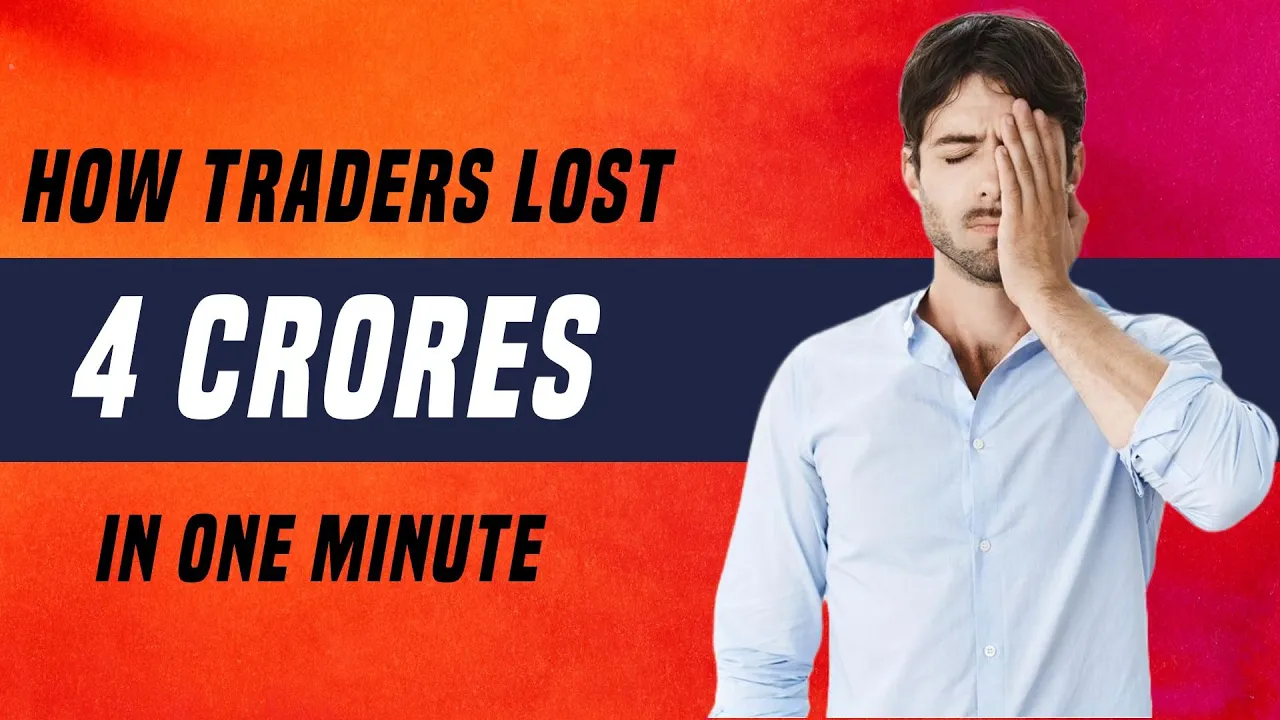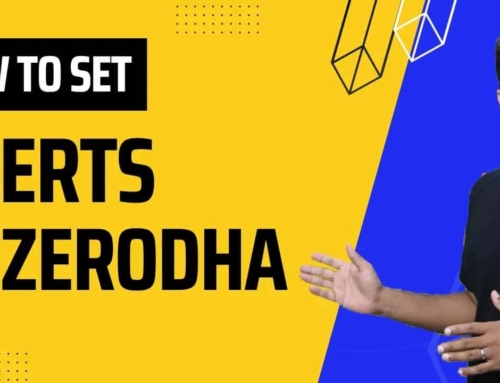How Traders Lost 4 Crores in One Minute?
Introduction
A very fascinating event happened just a few weeks back. And I thought it will be interesting to discuss about that. And there are some teachable moments that we can learn from this incident as well. So, this incident happened on 11th of August, 2023, around 9:45 AM during market hours. So, life was going fine as usual.
Market was calm. Nifty was calm. Bank Nifty was calm. When all of a sudden Bank Nifty’s 45,700 put option fell over 90 percent within a fraction of a second. Now remember, there was nothing happening in the market at that time, right. Everything was calm and there was no reason for this option to fall this much.
Why did it happen?
So, it turns out that it was an order entry issue, right. You can even call it a fat finger mistake. There were a bunch of traders who were subscribed to a ready-made algo, right? There are people out there who are buying these ready-made algos for, you know, some kind of a strategy.
This algo was basically operating the accounts of these traders and sending buy and sell orders whenever there was a signal for that. Around this 9:45 AM this algo wanted to sell 45,700 call option, right? Which is right here. You can see this one. So, this call option was trading at the time around 90 rupees.
But instead of selling the call option, the algo triggered orders for selling put option. Now for this particular strike, if you compare the call option and put option, there is a huge difference, right? The call option is clearly out of money. It’s very cheap around 90 rupees, but the put option is deep in the money and at the time it was trading at 1300 rupees.
When these orders were sent for this put option, imagine how much cheaper these traders were selling that put option, right? The fair value of the put option is around 1300 rupees, whereas these guys sold that option at 90 rupees. Hence, it was over 90 percent of discount from its fair value.
Now, what happens is that there are algos in this market that are specifically designed to take advantage of these arbitrage opportunities, right. Anything which is being sold at a cheaper price than its fair value, especially at this kind of a discount, there will always be some algo to buy that at that cheap value.
And that is exactly what happened. And of course, it was a very profitable trade for them because this 90-rupee option went up to 1300 rupees within a matter of seconds. In other words, if you bought this option for one lakh rupees at the time, that one lakh rupees would have turned to 15 lakh rupees right away.
Okay. This is how big discrepancy was there in this particular trade. As you guys know that trading is a zero-sum game, it means that one person’s profit is another person’s loss. So, who’s going to be loser in this equation? Well, clearly those people who are following that algo, who sold this option at 90 rupees, they had to incur this huge loss. And by some estimates, the total loss of all these traders combined was around 4 crore rupees.
Now, let’s just take a step back and think about this for a second that a lot of weird things happen in the stock market, right? We don’t really get surprised a lot, but this particular issue should ideally not have happened, right. Of course, there was a mistake from the algo side, but on the exchange front, there is a mechanism in place that avoids these kinds of freak trades.
It’s what about exactly am I talking about? Well, if you read through this article, which is from Zerodha, you will understand that there is a concept of limit price protection for anything that we trade in index or stock options, right.
What that means is that for options with a premium value greater than 50, which was in this case, the range is plus minus 40%.
If there is any order, which is coming beyond this range on the upside, 40% on the downside, 40%. So, for a 50-rupee option, that will be like 70 rupees on the upside and 30 rupees on the downside. Hence, if any order comes above 70 rupees or less than 30 rupees, that order should ideally get rejected at the stock exchange.
You will get an error message, something like this.
Then the question comes that the option was trading at 1300 bucks. And this order was sent at 90 rupees. It was clearly beyond the limit price protection. So why did the exchange allow these orders to get executed? Right? So far exchanges have denied that and there was any problem from their end.
But if you understand the stock market, guys, this is one thing I will tell you very honestly, if you ever incur a loss, nobody will take responsibility for that. And I myself have gone through this. In fact, you can watch that video. In Zerodha, there is a feature called Kill Switch.
And at one point of time, I activated the kill switch and it’s kill switch job to make sure that none of the pending order should be there before it gets activated. And once kill switch is activated, it should not allow any orders to go through. Still Kill switch allowed the orders to go through and I incurred a loss of about 30 – 40 thousand rupees.
And even though Zerodha later acknowledged that there was a system issue on their part, they completely ignored my request of any kind of a refund. So, there is absolutely, positively, there is nobody who will ever give you your money back unless you take it legally.
Key Learnings
Now that brings me to the teachable moment. It’s all fascinating to hear about weird incidences or freak trades like this, but can we learn something from this? And I believe, yes, there is a very important learning from this incident.
The learning is that algos are becoming more and more popular in this trading world. And even though they’re bringing a lot of speed. They’re also bringing some potential issues, right. So, if you make mistakes through algos, sometimes these mistakes can be very expensive, like the case that we just saw.
And by the way, this confusion between call option and put option has happened to me as well. So, for us also, when we were trying to know, to build a program for the first time where when adjustments were supposed to be done, when the stop loss of one of the options got hit. Our algo also made a similar mistake when rather than, selling a call option, we sold a put option and vice versa.
What we did was that we built checks and balances in the system to ensure that any such error is spotted before even the order goes to the stock exchange. So, what we did was we built a very simple logic that if we are sending any order with a specific price, we validate that price with the 30-period moving average of that option in the last half an hour.
Therefore, basically that is to make sure that if the price at which we are sending, if that price is way above the simple moving average of the last half an hour, then there is definitely a problem. And somebody has to manually check that before sending that order and then this checks itself has saved us from a lot of trouble.
Conclusion
The key learning here is algos are good, but please make sure that whichever algos you yourself are designing, or if you are getting it built from somewhere else, make sure that every single logic that you’re building, there are some checks and balances to make sure that the logic is foolproof.
If you had any similar instances where you incurred a loss or even incurred a profit for that matter, let us know in the comments below. I always think about these instances and like, you know, feel like there is somebody out there who makes a lot of money on these freak trades.
It is never me. Somehow it always happens that the freak trades go against me, not in my favour, but you know, it’s a, it’s a matter of luck. In the long run with all evens out. But yeah, the key lesson here is that take extreme precaution when working with algos.
Subscribe to our channel Now.
Howdy!
If you’re here for the first time, let’s get introduced.
VRD Nation is India’s premier stock market training institute and we (Team VRD Nation) are passionate about teaching each and every aspect of investing and trading.
If you’re here for the first time, don’t forget to check out “Free Training” section where we have tons of free videos and articles to kick start your stock market journey.
Also, we got two awesome YouTube channels where you can continue the learning process.
Must-Read Articles
How Traders Lost 4 Crores in One Minute?
Introduction
A very fascinating event happened just a few weeks back. And I thought it will be interesting to discuss about that. And there are some teachable moments that we can learn from this incident as well. So, this incident happened on 11th of August, 2023, around 9:45 AM during market hours. So, life was going fine as usual.
Market was calm. Nifty was calm. Bank Nifty was calm. When all of a sudden Bank Nifty’s 45,700 put option fell over 90 percent within a fraction of a second. Now remember, there was nothing happening in the market at that time, right. Everything was calm and there was no reason for this option to fall this much.
Why did it happen?
So, it turns out that it was an order entry issue, right. You can even call it a fat finger mistake. There were a bunch of traders who were subscribed to a ready-made algo, right? There are people out there who are buying these ready-made algos for, you know, some kind of a strategy.
This algo was basically operating the accounts of these traders and sending buy and sell orders whenever there was a signal for that. Around this 9:45 AM this algo wanted to sell 45,700 call option, right? Which is right here. You can see this one. So, this call option was trading at the time around 90 rupees.
But instead of selling the call option, the algo triggered orders for selling put option. Now for this particular strike, if you compare the call option and put option, there is a huge difference, right? The call option is clearly out of money. It’s very cheap around 90 rupees, but the put option is deep in the money and at the time it was trading at 1300 rupees.
When these orders were sent for this put option, imagine how much cheaper these traders were selling that put option, right? The fair value of the put option is around 1300 rupees, whereas these guys sold that option at 90 rupees. Hence, it was over 90 percent of discount from its fair value.
Now, what happens is that there are algos in this market that are specifically designed to take advantage of these arbitrage opportunities, right. Anything which is being sold at a cheaper price than its fair value, especially at this kind of a discount, there will always be some algo to buy that at that cheap value.
And that is exactly what happened. And of course, it was a very profitable trade for them because this 90-rupee option went up to 1300 rupees within a matter of seconds. In other words, if you bought this option for one lakh rupees at the time, that one lakh rupees would have turned to 15 lakh rupees right away.
Okay. This is how big discrepancy was there in this particular trade. As you guys know that trading is a zero-sum game, it means that one person’s profit is another person’s loss. So, who’s going to be loser in this equation? Well, clearly those people who are following that algo, who sold this option at 90 rupees, they had to incur this huge loss. And by some estimates, the total loss of all these traders combined was around 4 crore rupees.
Now, let’s just take a step back and think about this for a second that a lot of weird things happen in the stock market, right? We don’t really get surprised a lot, but this particular issue should ideally not have happened, right. Of course, there was a mistake from the algo side, but on the exchange front, there is a mechanism in place that avoids these kinds of freak trades.
It’s what about exactly am I talking about? Well, if you read through this article, which is from Zerodha, you will understand that there is a concept of limit price protection for anything that we trade in index or stock options, right.
What that means is that for options with a premium value greater than 50, which was in this case, the range is plus minus 40%.
If there is any order, which is coming beyond this range on the upside, 40% on the downside, 40%. So, for a 50-rupee option, that will be like 70 rupees on the upside and 30 rupees on the downside. Hence, if any order comes above 70 rupees or less than 30 rupees, that order should ideally get rejected at the stock exchange.
You will get an error message, something like this.
Then the question comes that the option was trading at 1300 bucks. And this order was sent at 90 rupees. It was clearly beyond the limit price protection. So why did the exchange allow these orders to get executed? Right? So far exchanges have denied that and there was any problem from their end.
But if you understand the stock market, guys, this is one thing I will tell you very honestly, if you ever incur a loss, nobody will take responsibility for that. And I myself have gone through this. In fact, you can watch that video. In Zerodha, there is a feature called Kill Switch.
And at one point of time, I activated the kill switch and it’s kill switch job to make sure that none of the pending order should be there before it gets activated. And once kill switch is activated, it should not allow any orders to go through. Still Kill switch allowed the orders to go through and I incurred a loss of about 30 – 40 thousand rupees.
And even though Zerodha later acknowledged that there was a system issue on their part, they completely ignored my request of any kind of a refund. So, there is absolutely, positively, there is nobody who will ever give you your money back unless you take it legally.
Key Learnings
Now that brings me to the teachable moment. It’s all fascinating to hear about weird incidences or freak trades like this, but can we learn something from this? And I believe, yes, there is a very important learning from this incident.
The learning is that algos are becoming more and more popular in this trading world. And even though they’re bringing a lot of speed. They’re also bringing some potential issues, right. So, if you make mistakes through algos, sometimes these mistakes can be very expensive, like the case that we just saw.
And by the way, this confusion between call option and put option has happened to me as well. So, for us also, when we were trying to know, to build a program for the first time where when adjustments were supposed to be done, when the stop loss of one of the options got hit. Our algo also made a similar mistake when rather than, selling a call option, we sold a put option and vice versa.
What we did was that we built checks and balances in the system to ensure that any such error is spotted before even the order goes to the stock exchange. So, what we did was we built a very simple logic that if we are sending any order with a specific price, we validate that price with the 30-period moving average of that option in the last half an hour.
Therefore, basically that is to make sure that if the price at which we are sending, if that price is way above the simple moving average of the last half an hour, then there is definitely a problem. And somebody has to manually check that before sending that order and then this checks itself has saved us from a lot of trouble.
Conclusion
The key learning here is algos are good, but please make sure that whichever algos you yourself are designing, or if you are getting it built from somewhere else, make sure that every single logic that you’re building, there are some checks and balances to make sure that the logic is foolproof.
If you had any similar instances where you incurred a loss or even incurred a profit for that matter, let us know in the comments below. I always think about these instances and like, you know, feel like there is somebody out there who makes a lot of money on these freak trades.
It is never me. Somehow it always happens that the freak trades go against me, not in my favour, but you know, it’s a, it’s a matter of luck. In the long run with all evens out. But yeah, the key lesson here is that take extreme precaution when working with algos.



















![What is Virtual Contract Note [Zerodha]](https://www.vrdnation.com/wp-content/uploads/2023/10/maxresdefault-virtual-note-500x383.jpg)




Leave A Comment